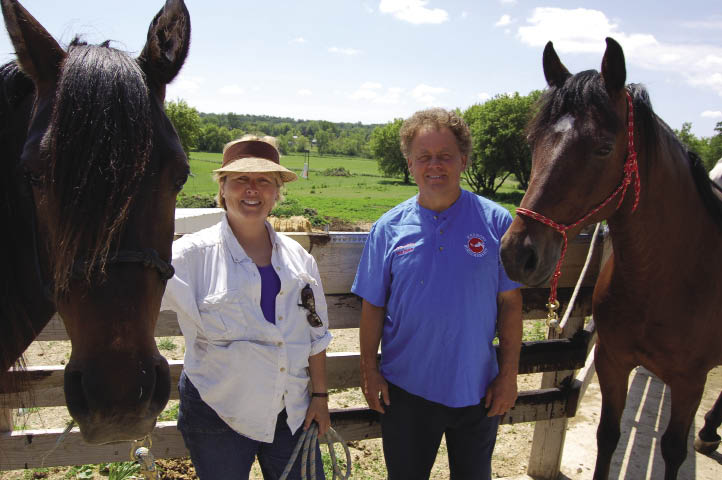
Paulette Stelpflug, (left) and Ted Schleuter, who operate Freedom Stables and Harmony Horsemanship, have invested in new equipment so they can get their chores done quicker. “If it requires 45 minutes to get the part and replace it, we don’t have time,” Stelpflug says.
There are few segments of the rural lifestyle market that have as wide and diverse membership as horse farms. But there’s little doubt that horse farms are growing in both popularity and numbers.
These farms — which range from professional breeding facilities to local stables to private owners — are emerging as a significant part of the economy in rural communities across North America.
The largest horse operations are generally breeding facilities that sell horses and semen, and they meet the USDA’s definition of a farm: “a place producing farm commodities having a market value of $1,000 or more annually.”
The more common types of horse farms, which may offer boarding and training services and riding lessons, don’t meet the USDA’s definition of a farm because they don’t produce commodities.
According to the American Horse Council Foundation, the horse industry directly produces goods and services of $25.3 billion and has a total impact of $112.1 billion on the U.S. gross domestic product.
The equine industry involves 7.1 million Americans, 6.9 million horses, and 1.4 million full-time jobs, according to the Horse Council’s statistics.
Rural Lifestyle Dealer interviewed both horse farm operators and equipment dealers with experience in the market to illustrate how versatile, reliable equipment can serve as a connecting point between customer and retailer.
Growing a Business
Helping horse farms succeed isn’t so much about having the largest equipment, but tools that are both reliable and versatile.
Ted Schleuter owns Harmony Horsemanship LLC and Freedom Stables, a 70-acre equestrian facility near Deerfield, Wis., that he operates with Paulette Stelpflug. The business specializes in natural horsemanship methods and the fast-growing sport of Equi-Soccer.
Harmony Horsemanship serves as home to roughly 50 horses, and feeding them is a major job. On a recent day, Stelpflug arrived at the barn for chores, just as Schleuter started up a new John Deere 4WD Gator XUV he purchased in April.
He maneuvered it with an attached feed cart down the barn aisle as Stelpflug quickly grained each horse. The horses were then turned out to their designated pastures. The morning feeding continued with the outdoor horses.
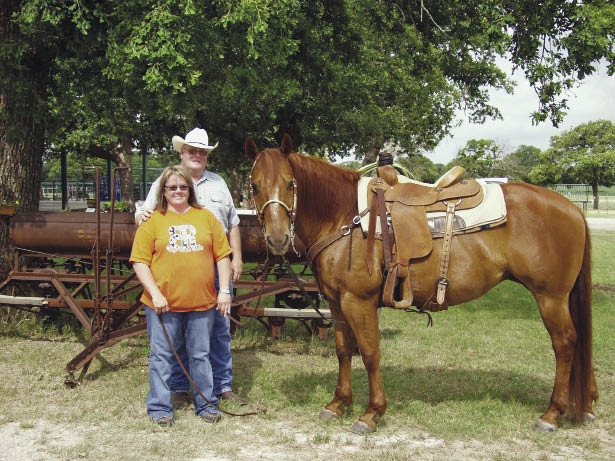
Wayne and Stacy Lynn have a close relationship with their equipment dealer, David Halford of Hendershot Equipment, because of their mutual involvement in horse events. “Plus, we’re kin folk,” Stacy says. “If we’re working cattle he’ll come work with us.”
As feeders were reloaded, Schleuter noticed a fence that needed repair. Thanks to some seat covers with zipper compartments that be bought for the UTV, he didn’t have to walk back to the stable to get wire cutters, insulators or other miscellaneous fence tools.
“Those seat covers are pretty nice. It really saves us time,” says Stelpflug.
There’s more heavy lifting to be done: Manure piles up overnight that must be replaced with fresh shavings, hay must be hauled, the arena must be leveled and the pastures mowed.
“That utility vehicle is the most important piece of equipment here, we use it for so much of our daily choring,” says Schleuter. “We even get the mail with it.”
Schleuter also owns an AGCO GT 65 tractor that’s used to move large round bales, mow pastures, apply fertilizer and remove snow, but the UTV is the daily workhorse on this horse farm.
In addition, he owns a Mill Creek ground-driven compact manure spreader that he can maneuver down the barn aisles; an Arena Rascal arena leveler pulled behind his UTV to level the riding arenas and gravel driveway; and a mower for broadleaf control and mowing pastures.
When it comes time to buy, Stelpflug and Schleuter look for equipment that makes their lives easier so they can spend every minute possible with their horses and clients. Dependability is another key factor for this two-person farm operation.
“We take care of what we have, but we don’t have the time for big-fix jobs,” says Stelpflug. “If it requires 45 minutes to get the part and replace it, we don’t have time. That’s why we buy items like the utility vehicle, the spreader and the King Kutter rotary cutter brand new.”
The lightly used 2005 AGCO tractor has worked out well. “This is a smaller operation, so we don’t need anything super huge and brand new,” says Stelpflug. “A $200,000 tractor won’t pay for itself. But we do need to move hay wagons and round bales frequently and reliably.”
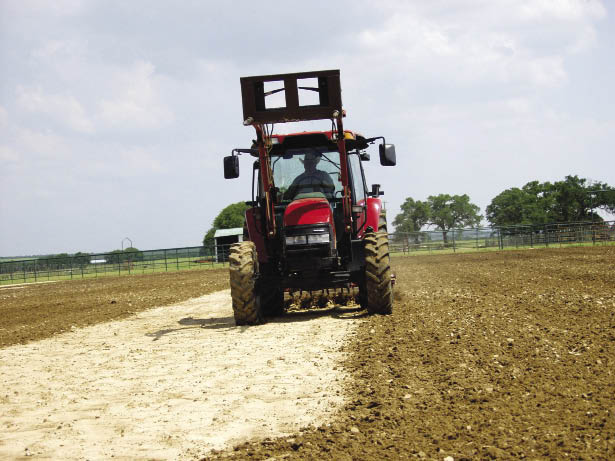
Horse farms need arena groomers to keep their grounds in top shape for the animals, as well as spears to move hay bales. At LF Ranch, Wayne Lynn’s Case IH JX 1100U tractor operates with shop-made spears and a Parma arena groomer.
When making important buying decisions, the partners depend on Mid-State Equipment, a 6-store network of John Deere dealerships in southern Wisconsin. They frequent a Mid-State dealership in Janesville, Wis., that caters to the needs of rural lifestylers.
Jennifer Green, a sales representative there, comes from a dairy background but has taken the time to understand the needs of equine customers. “It’s more than just selling equipment,” she says. “It’s helping people grow their business by selling them equipment that makes them more productive.
“With my equine customers, they’ve done a lot of research, and they definitely know what their needs are. They don’t have time to shop around. They want to spend time with their horses. So our job is to suggest equipment that meets their needs very precisely. Once you sell something, you create a relationship.”
“We depend on excellent service from our dealership, and Jenny has the ability to make you feel you’re part of their business,” Stelpflug says. “She takes the time to understand our needs and makes suggestions.”
As a result of this two-way dialog, the partners added several enhancements to their UTV — a hard-cover top, full windshield and upgraded bed liner and fender guards.
“She got to know us so well that she thought it would be fun if we provided the entertainment for their spring open house,” says Stelpflug. “We’re always looking for ways to spread the word about Equi-Soccer and natural horsemanship, so we said ‘yes.’ ”
“That was something we’d never done before, and people definitely took an interest in it,” adds Green. “People came in, looked around, got a sandwich, watched the soccer, and they lingered here all day. We couldn’t have asked for a better day. It was just beautiful — a lot of traffic.
‘I’ve Seen the Inside’
Another example of the incredible diversity can be found in Stephenville, Texas, which is known as the “Cowboy Capital of the World.”
It’s home to Lone Star Arena, which hosts some of the most prestigious western equestrian events in the nation — roping, reining, cutting, barrel racing, rodeos and more.
With so many national events happening year-round, the region serves as home for some of the nation’s top trainers, competitors and hay burners.
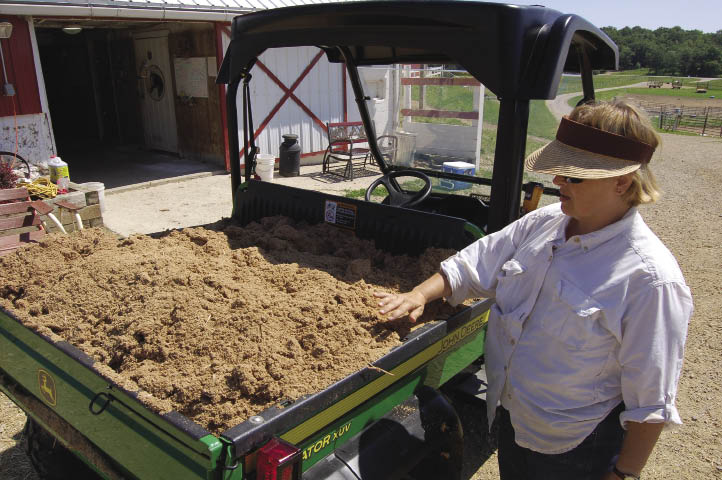
The new John Deere Gator XUV used at Harmony Horsemanship and Freedom Stables has a dump bed for hauling bulk material around the property — a chore that was previously done with a wheel barrow, says Paulette Stelpflug.
One area dealership that has successfully grown with the local horse industry is Hendershot Equipment Co., in Stephenville, Texas, one of Farm Equipment’s “Best-in-Class” dealers in 2008. Salesman David Halford knows his horse customers well: He and his 2 children routinely participate in team roping competitions.
“I’ve been involved with horses forever,” says Halford. “I own horse property, I’ve bought a variety of equipment through the years, and I do everything from horse roping to selling tractors. I have a full-time job and a full-time hobby. It’s a big part of the culture here.”
Halford’s full-time hobby gives him an advantage when it comes to selling equipment to horse farms. Aside from the hundreds of sales leads he gets by participating in equestrian events, he has a first-hand understanding of what horse people need to efficiently run their farms.
“I’ve seen the inside, so I know what they’re looking for when they come in,” says Halford. “I also get a lot of the leads from the events we go to. We always bring our cards and advertise, because you’ve got to be in front of them. They’ve got to know that you’re in the business, too.”
With horses taking up so much of the farm landscape, Hendershot carries the tractors, hay equipment, loaders, mowers, arena groomers, shredders and weed eaters that get the most interest.
“Our Farmall series works well,” notes Halford. “Even a 10- or 15-acre operation needs a tractor and an arena plow, so those are the primary products to start with. Then we’ll follow up with weed eaters and posthole diggers.”
Halford also cites the importance of after-sales service and support. “Our customers rely on that equipment, it’s very important to them,” he says. “And we all know that if you can’t fix it, you can’t sell it.”
Tool for Every Job
Just 20 miles west of Stephenville, the former oil boomtown of Desdemona, Texas, was once home to as many as 16,000 residents in the 1920s.
Today it’s become a virtual ghost town with fewer than 200 residents. But on sprawling ranches just outside of Desdemona, sport horses and sport cattle are riding a boom all their own.
Stacy and Wayne Lynn, owners of LF Ranch and lifetime members of the American Quarter Horse Assn. and North American Corriente Cattle Assn., own herds of horses and cows and grow hay and wheat for grazing. They’ve acquired a wide array of equipment from Hendershot
The Lynns specialize in training roping horses, and have roughly 10 horses in training at any given time. They also breed and raise Corriente sport cattle, which are used in today’s most popular equestrian events like team roping.
Nearly all aspects of their farm work involve either a tractor or skid-steer loader, and they’re used with a variety of different attachments and implements.
“Most of our facility is set up where we can do it with the machinery instead of doing in manually,” says Stacy.
According to the Lynns, the couple’s Case IH JX 1100U tractor and LX232 loader attachment is the lifeblood of their busy farm operation.
The tractor is used to feed the horses and cattle, clean out the horse stalls and pens and keep the riding arena in top condition. The loader comes in handy to move large manure piles, clean pens, and move sand into the arena.
Their 6640 Gehl skid-steer is used in tight spaces for moving manure and cleaning horse stalls and pens with a bucket attachment. The Lynns also own two Polaris Ranger ATVs — a single cab and crew cab — used for checking pastures, transporting feed and other general chores.
Attachments play a key role, the couple says. A shop-made hay fork that attaches to the tractor is used to move large round bales, while a Parma arena groomer does the basic arena grooming.
An Alamo-Rhino 15-foot rotary cutter is used with the tractor to cut tall grass, the AerWay aerator aerates cattle pastures and hay fields, and a Rock Rake bucket attachment is used to clear brush and rocks.
Tillage tools used on the farm include a Krause disc plow to break up ground in the arena and elsewhere, clear land and prepare grazing pastures for planting, and an Alamo-Rhino 8-foot tiller to loosen up the arena ground and livestock pens. The Lynns also own a Dixon riding lawn mower.
The couple’s relationship with Halford is both personal and professional. “We used to rope all the time, and we’re around each other quite a bit at horse functions,” says Stacy. “Plus, we’re kin folk. If we’re working cattle he’ll come work with us.”
The Lynns agree that efficiency is key for them, so they can spend more time with their animals. “We keep a set of show horses that we rope, and like any animal you need to train them so they can perform to the best of their ability,” says Stacy Lynn. “Our horses and cattle all work together, so it’s a neat deal.”
Small Square Balers a Growing Market
The average horse consumes at least 10 pounds of hay each day. With nearly 7 million horses in the U.S., that adds up to more than 70 million pounds of hay consumed daily.
To complicate the equation, consider the horse’s delicate digestive system. While each individual is different, horses generally require smaller quantities of hay fed throughout the day. Small bales work best, but quality small bales are often hard to find.
Unlike production farms, horse farms are getting smaller. Many simply don’t have the time or space to plant and harvest hay, and those who do may choose to leave hay production to the local hay experts. “Even though we grow our own hay, we have it baled,” notes Stacy Lynn of LF Ranch in Desdemona, Texas.
It all adds up to a supply challenge for today’s horse farm operators — and a significant opportunity for both hay growers and equipment dealers.
To meet the demand from growers who cater to the so-called “boutique” small square horse hay market in and around Stephenville, Texas, Hendershot Equipment carries a complete line of Vermeer small-square balers.
David Halford of Hendershot notes the demand for such equipment has increased steadily over the past 10 years, due to the influx of horses. “Dairy has been in a downturn, so it’s good that the horse market has stepped up,” he says.

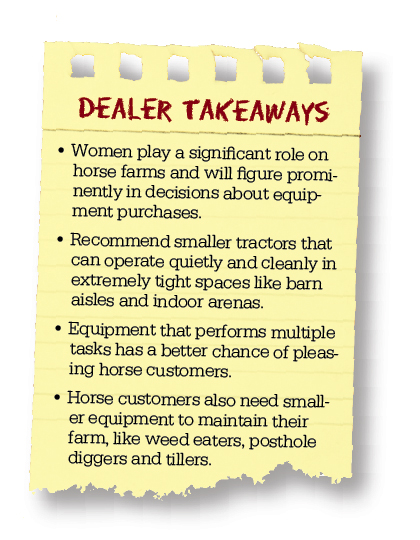



Post a comment
Report Abusive Comment